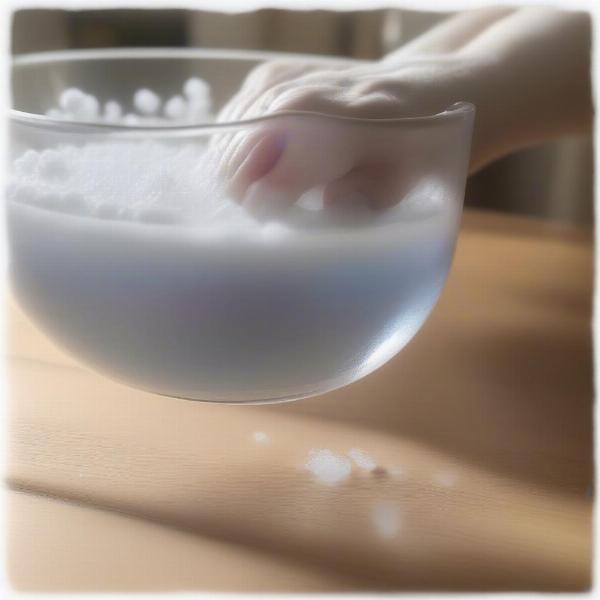Epsom salt, known chemically as magnesium sulfate, is a common household item often used for muscle aches and pains in humans. But what about its use for our furry friends, specifically for an epsom salt dog paw soak? This article will explore the potential benefits and risks of using epsom salt for dog paw soaks, providing you with the information you need to make informed decisions about your dog’s paw care.
Understanding Epsom Salt and its Potential Benefits for Dogs
Epsom salt is believed to work by drawing out toxins and reducing inflammation. For dogs, an epsom salt paw soak is often touted as a home remedy for various paw ailments, including minor irritations, swelling, and dryness. It’s important to note, however, that scientific evidence supporting these claims is limited. While anecdotal evidence suggests some benefits, always consult your veterinarian before using epsom salt on your dog, especially if they have any underlying health conditions.
 Epsom salt being dissolved in warm water for a dog paw soak
Epsom salt being dissolved in warm water for a dog paw soak
Preparing an Epsom Salt Soak for Your Dog’s Paws
If your veterinarian approves the use of epsom salt for your dog’s paws, it’s crucial to prepare the soak correctly. Use warm, not hot, water and dissolve the epsom salt completely. A general guideline is to use about two tablespoons of epsom salt per gallon of water, but always follow your veterinarian’s recommendations for the appropriate concentration.
How to Administer an Epsom Salt Paw Soak
Once the epsom salt is fully dissolved, gently place your dog’s affected paw(s) in the solution. Hold the paw in the soak for 5-10 minutes. If your dog resists, don’t force them. Positive reinforcement, like treats and praise, can help make the experience more pleasant. After the soak, thoroughly dry your dog’s paws to prevent further irritation.
Potential Risks and Precautions
While generally considered safe when used correctly, epsom salt can pose some risks. If ingested, it can cause diarrhea. Therefore, monitor your dog closely during and after the soak to ensure they don’t lick the solution. Also, avoid using epsom salt on open wounds or severely irritated skin. If your dog’s paw condition doesn’t improve or worsens after a few soaks, consult your veterinarian. They can diagnose the underlying cause and recommend the appropriate treatment.
When to Consult a Veterinarian
An epsom salt soak can provide temporary relief for minor paw irritations, but it’s not a cure-all. If your dog exhibits signs of pain, swelling, redness, discharge, or persistent licking, it’s crucial to seek professional veterinary care. dogs paws red and swollen These symptoms could indicate an underlying infection, allergy, or other medical condition that requires specific treatment. dog foot pad swollen Don’t rely solely on home remedies; early diagnosis and treatment are essential for preventing complications.
Conclusion
Epsom salt paw soaks may offer a soothing solution for minor dog paw irritations, but their effectiveness is largely based on anecdotal evidence. Always consult your veterinarian before using epsom salt on your dog, and never use it as a substitute for professional veterinary care. how to treat dog paw infection at home Proper paw care is essential for your dog’s overall health and well-being, and professional guidance ensures the best possible outcome for your furry friend. dog paw soak home remedies for dog licking paws
FAQ
- How often can I give my dog an epsom salt paw soak? Consult your veterinarian for specific guidance, but generally, a few times a week is considered safe for minor irritations.
- Can I use epsom salt on my puppy’s paws? It’s best to consult your veterinarian before using epsom salt on puppies.
- What are some other ways to soothe my dog’s irritated paws? Consult your vet for appropriate treatments which could include medicated paw balms or washes.
- What are the signs of a serious paw infection? Swelling, redness, discharge, persistent licking, and limping are all potential signs of a paw infection.
- Is it okay if my dog licks the epsom salt solution? No, ingesting epsom salt can cause diarrhea. Monitor your dog closely and prevent them from licking the solution.
- Can I use scented epsom salts on my dog’s paws? It’s best to stick to unscented epsom salt to avoid potential skin irritation.
- What should I do if my dog’s paw condition doesn’t improve after an epsom salt soak? Consult your veterinarian for further evaluation and appropriate treatment.
ILM Dog is your trusted partner in canine care. We offer expert advice and resources on everything from breed selection and training to health, nutrition, and grooming. Our mission is to empower dog owners worldwide with the knowledge they need to provide the best possible care for their beloved companions. With articles covering a wide range of topics, including choosing the right breed, understanding dog behavior, and providing optimal nutrition, ILM Dog is your go-to resource for all things dog-related. Contact us at [email protected] or +44 20-3965-8624 for personalized guidance and support.